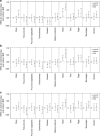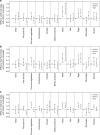Mother's body mass index and food intake in school-aged children: results of the GINIplus and the LISAplus studies
- PMID: 24848629
- PMCID: PMC4283383
- DOI: 10.1038/ejcn.2014.92
Mother's body mass index and food intake in school-aged children: results of the GINIplus and the LISAplus studies
Abstract
Background/objectives: Mother's body mass index (BMI) is a strong predictor of child BMI. Whether mother's BMI correlates with child's food intake is unclear. We investigated associations between mother's BMI/overweight and child's food intake using data from two German birth cohorts.
Subjects/methods: Food intakes from 3230 participants were derived from parent-completed food frequency questionnaires. Intakes of 11 food groups were categorized into three levels using group- and sex-specific tertile cutoffs. Mother's BMI and overweight were calculated on the basis of questionnaire data. Multinomial regression models assessed associations between a child's food intake and mother's BMI/overweight. Linear regression models assessed associations between a child's total energy intake and mother's BMI. Models were adjusted for study region, maternal education, child's age, sex, pubertal status and energy intake and the BMIs of the child and father.
Results: Mothers' BMI was associated with high meat intake in children (adjusted relative risk ratio (RRR (95% confidence interval))=1.06 (1.03; 1.09)). Mothers' overweight was associated with the meat intake (medium versus low RRR=1.30 (1.07; 1.59); high versus low RRR=1.50 (1.19; 1.89)) and egg intake (medium versus low RRR=1.24 (1.02; 1.50); high versus low RRR=1.30 (1.07; 1.60)) of children. There were no consistent associations for rest of the food groups. For every one-unit increase in mothers' BMI, the total energy intake in children increased by 9.2 kcal (3.7; 14.7). However, this effect was not significant after adjusting for children's BMI.
Conclusions: Our results suggest that mother's BMI and mother's overweight are important correlates of a child's intake of energy, meat and eggs.
Figures



Similar articles
-
[Simple obesity in children. A study on the role of nutritional factors].Med Wieku Rozwoj. 2006 Jan-Mar;10(1):3-191. Med Wieku Rozwoj. 2006. PMID: 16733288 Review. Polish.
-
Drivers of overweight mothers' food choice behaviors depend on child gender.Appetite. 2015 Jan;84:154-60. doi: 10.1016/j.appet.2014.09.024. Epub 2014 Oct 6. Appetite. 2015. PMID: 25300916 Free PMC article. Clinical Trial.
-
The association between weight perception and BMI: report and measurement data from the growing up in Ireland Cohort Study of 9-year olds.Int J Obes (Lond). 2017 Jan;41(1):46-53. doi: 10.1038/ijo.2016.162. Epub 2015 Sep 27. Int J Obes (Lond). 2017. PMID: 27671034
-
Mothers' child-feeding practices are associated with children's sugar-sweetened beverage intake.J Nutr. 2015 Apr;145(4):806-12. doi: 10.3945/jn.114.207233. Epub 2015 Feb 18. J Nutr. 2015. PMID: 25833783 Free PMC article.
-
Correlates of children's dietary intake in childcare settings: A systematic review.Nutr Rev. 2022 Apr 8;80(5):1247-1273. doi: 10.1093/nutrit/nuab123. Nutr Rev. 2022. PMID: 35393619
Cited by
-
Parental body mass index and its association with body composition, physical fitness and lifestyle factors in their 4-year-old children: results from the MINISTOP trial.Eur J Clin Nutr. 2017 Oct;71(10):1200-1205. doi: 10.1038/ejcn.2017.62. Epub 2017 May 3. Eur J Clin Nutr. 2017. PMID: 28466851 Clinical Trial.
-
Parental child feeding practices and their relationship with children's dietary intake and weight status in Nepal.J Multidiscip Healthc. 2019 Apr 30;12:325-333. doi: 10.2147/JMDH.S195106. eCollection 2019. J Multidiscip Healthc. 2019. PMID: 31118656 Free PMC article.
-
Obesogenic dietary intake in families with 1-year-old infants at high and low obesity risk based on parental weight status: baseline data from a longitudinal intervention (Early STOPP).Eur J Nutr. 2016 Mar;55(2):781-792. doi: 10.1007/s00394-015-0899-9. Epub 2015 Apr 18. Eur J Nutr. 2016. PMID: 25893717 Free PMC article.
-
Mother's dietary quality during pregnancy and offspring's dietary quality in adolescence: Follow-up from a national birth cohort study of 19,582 mother-offspring pairs.PLoS Med. 2019 Sep 12;16(9):e1002911. doi: 10.1371/journal.pmed.1002911. eCollection 2019 Sep. PLoS Med. 2019. PMID: 31513597 Free PMC article.
-
Preschool Children's Eating Habits and Parental Nutritional Status.Nutrients. 2025 Feb 5;17(3):575. doi: 10.3390/nu17030575. Nutrients. 2025. PMID: 39940433 Free PMC article.
References
-
- James PT, Leach R, Kalamara E, Shayeghi M. The worldwide obesity epidemic. Obes Res. 2001;9:228S–233S. - PubMed
-
- International Obesity Taskforce. Obesity the global epidemic. 2011. Available at: http://www.iaso.org/iotf/obesity/obesitytheglobalepidemic/ .
-
- Birbilis M, Moschonis G, Mougios V, Manios Y. Obesity in adolescence is associated with perinatal risk factors, parental BMI and sociodemographic characteristics. Eur J Clin Nutr. 2013;67:115–121. - PubMed
-
- Danielzik S, Langnase K, Mast M, Spethmann C, Muller MJ. Impact of parental BMI on the manifestation of overweight 5-7 year old children. Eur J Clin Nutr. 2002;41:132–138. - PubMed
Publication types
MeSH terms
LinkOut - more resources
Full Text Sources
Other Literature Sources
Medical

